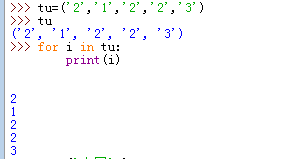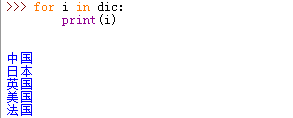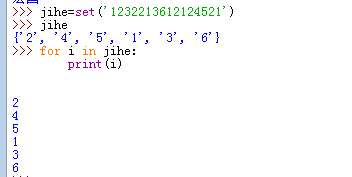- 字典实例:建立学生学号成绩字典,做增删改查遍历操作。
print('为字典c添加键-值:') c={} c['001']='70分' c['002']='65分' c['003']='100分' c['004']='85分' c['005']='75分' print(c) print('删除学号为002的键-值:') del(c['002']) print(c) print('添加学号新键值:') c['002']='98分' print(c) print('改变键为003的值:') c['003']='75分' print(c) print('判断是否含006键值:') print(c.get('006')) print('查询002的值:') print(c['002'])

2.列表,元组,字典,集合的遍历。
ls=['1','2','3','2'] print(ls) for i in ls: print(i)

tu=('2','1','2','2','3') print(tu) for i in tu: print(i)

dic={} dic['中国']='北京' dic['日本']='东京' dic['英国']='伦敦' dic['美国']='华盛顿' dic['法国']='巴黎' print(dic) for i in dic: print(i)


jihe=set('1232213612124521') print(jihe) for i in jihe: print(i)

总结列表,元组,字典,集合的联系与区别。
列表:可重复,类型可不同。类型不同也是跟数组最本质的区别了。python里的列表用“[]”表示。
列表是可变对象,它支持在原处修改的操作.也可以通过指定的索引和分片获取元素。
区别于元组,可动态增加,删除,更新。
可以和字符串作为比较。因为字符串具备列表的一些特点。
元组:和列表在结构上没有什么区别,唯一的差异在于元组是只读的,不能修改。元组用“()”表示。
元组一旦定义其长度和内容都是固定的。
一旦创建元组,则这个元组就不能被修改,即不能对元组进行更新、增加、删除操作。
若想创建包含一个元素的元组,则必须在该元素后面加逗号“,”,否则创建的不是一个元组,而是一个字符串。
字典:存储键值对数据。
字典最外面用大括号,每一组用冒号连起来,然后各组用逗号隔开。
字典最大的价值是查询,通过键,查找值。
集合:即数学的集合,没有什么特殊的定义。集合最好的应用是去重。所以,集合内的元素没有重复的元素。
集合没有特殊的表示方法,而是通过一个set函数转换成集合。
集合是一个无序不重复元素集,基本功能包括关系测试和消除重复元素.。
由于集合是无序的。所以,sets 不支持 索引, 分片,或其它类序列(sequence-like)的操作。
注意:字典和集合都是无序的。
- 3.英文词频统计实例
- 待分析字符串
- 分解提取单词
- 大小写 txt.lower()
- 分隔符'.,:;?!-_’
- 单词列表
单词计数字典
read='''May I have your attention, please.As you know, our class will have a talk show on environment protection with Class One on May 4th.Before it takes place, we will invite Dr Li from Qinghua University to give us a talk on the environment problem and he will also tell us about t he improvement in environment protection in recent years in Beijing. The report will begin at 2:00 pm on Wednesday, April 30th in the auditorium on the third floor in the classroom building. I’m sure we can get enough information from his talk to make good preparations for the coming talk show. everyone should be there on time, then listen to the report and make full notes at the same time. By the way, we will have a discussion after the report. That is all. Thank you.''' print('短文中各个短语出现的次数:') read=read.lower() for i in ',.': read=read.replace(i,' ') words=read.split(' ') di = {} words.sort() disc = set(words) for i in disc: di[i] = 0 for i in words: di[i] = di[i]+1 new = di.items() print(new)

转载于:https://www.cnblogs.com/1996liuda/p/7595975.html
最后
以上就是跳跃康乃馨最近收集整理的关于组合数据类型练习,英文词频统计实例上的全部内容,更多相关组合数据类型练习内容请搜索靠谱客的其他文章。
本图文内容来源于网友提供,作为学习参考使用,或来自网络收集整理,版权属于原作者所有。








发表评论 取消回复